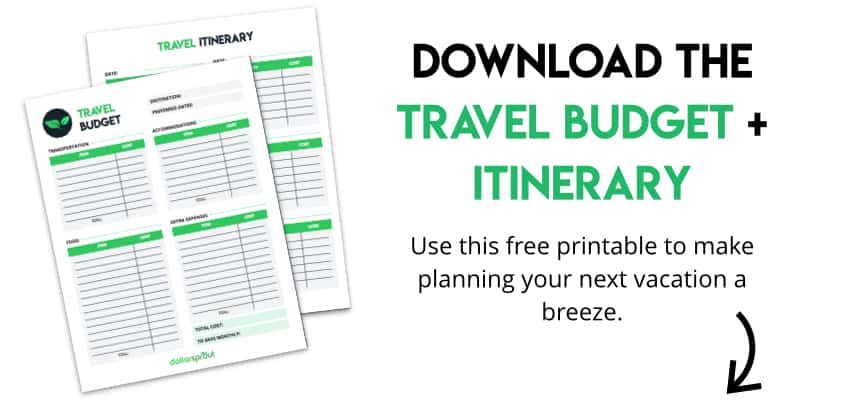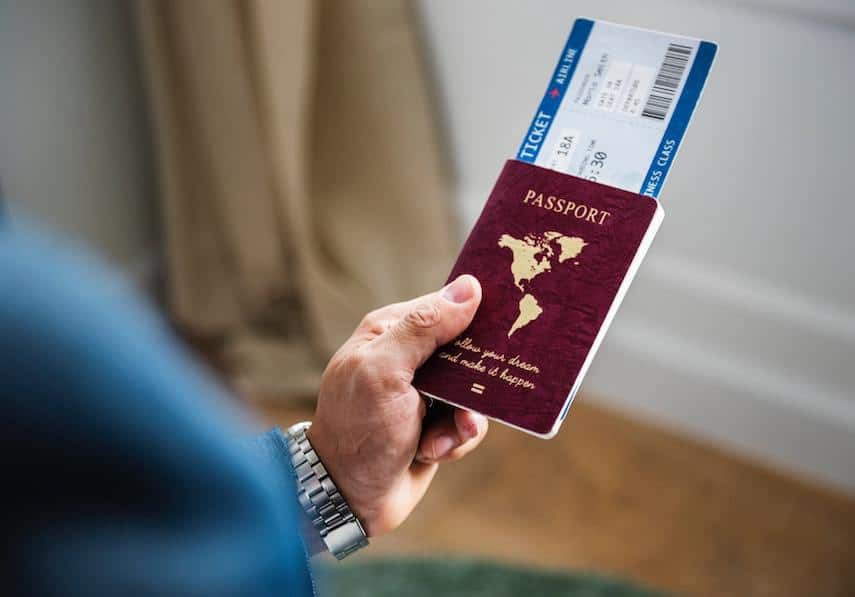How to Make a Travel Budget in 5 Easy Steps (Free Planner)
Our readers always come first
The content on DollarSprout includes links to our advertising partners. When you read our content and click on one of our partners’ links, and then decide to complete an offer — whether it’s downloading an app, opening an account, or some other action — we may earn a commission from that advertiser, at no extra cost to you.
Our ultimate goal is to educate and inform, not lure you into signing up for certain offers. Compensation from our partners may impact what products we cover and where they appear on the site, but does not have any impact on the objectivity of our reviews or advice.
Creating a travel budget may seem like a hassle, but it’ll actually make your vacation more enjoyable. Knowing that you’ve already planned out how you’re going to pay for everything will help you relax and have a good time.
Some of the links on DollarSprout point to products or services from partners we trust. If you choose to make a purchase through one, we may earn a commission, which supports the ongoing maintenance and improvement of our site at no additional cost to you. Learn more.
Many people enjoy traveling the world, exploring new places, or just relaxing in a tranquil environment.
Taking a vacation is a great way to reduce stress and improve productivity, but traveling can be costly. Making a travel budget will make a big difference while planning your next getaway.
Those who love to travel should incorporate it as a line item in their monthly budgets. Each month, set aside a certain amount for travel in its own separate account.
Earmark that money specifically as a vacation budget so that it can be spent guilt-free. Money that is put toward trip expenses can simply be reimbursed from the travel account.
With that said, if there is outstanding debt that is difficult to pay off, planning an immediate vacation may not be a good idea. In this case, the priority should be to set up an emergency fund that includes three-to-six months’ worth of living expenses.
Why Is Budgeting for a Vacation Important?
While it is good to get into the habit of setting aside vacation funds every month, it is also important to create a budget for each individual trip. This will help determine how long it will take to build up enough money in the vacation account to pay for that trip. It will also allow for logistics to be planned out, while staying on budget.
Scheduling and budgeting for vacations can be very enjoyable. Researching hotel accommodations, restaurants, and free things to do helps to build up anticipation. It can be fun for the whole family to spend time together, figuring out the different parts of an upcoming trip.
How to Budget for A Vacation in 5 Simple Steps
When it comes time to map out those vacation expenses, a few key steps will help lead to success and worry-free traveling. Begin by drafting a well-rounded vacation budget, focusing on expenses in the following five main categories. Once these are figured out, the rest of the details will fall into place.
1. Choose a destination and preferred date
Start by picking a destination and nailing down travel dates. Remember that some locations are more expensive to visit than others. The time of year can also make a difference in pricing. Traveling done at peak tourist times usually costs more than off-season trips.
Be flexible
Being flexible is one of the easiest ways to save when budgeting for a vacation. Check out multiple travel destinations and compare prices before settling on options for lodging and airfare. Since these are two of the largest expenses in any travel budget, keeping them in check will go a long way toward helping to keep the overall cost down.
Be willing to look at alternative accommodations or stay at a place that is a little farther away from the tourist areas. Remember that most vacation time is spent outside the hotel room – so there is no reason to put a large chunk of the budget toward nice accommodations that will be used only for sleep.
Also, be flexible when choosing a travel date. Many travel search engines have a “flexible dates” option that can be used to research the lowest prices for airfare and lodging. Plan around these dates for added savings in the travel budget.
Consider the season
The time of year can really impact a travel budget. A lot of people have begun to plan weddings around their honeymoons, and not vise versa. For example, if the goal is to travel to Italy without spending a fortune or facing large crowds of tourists – while still enjoying nice weather – get married in early autumn, which is known as the shoulder season. It’s a great time of year to travel, because the weather is still nice, but the crowds have thinned out. Most people with children travel during the summer. Once the kids are back in school, prices for airfare and accommodations tend to drop, allowing people with more flexibility to travel cheaper.
Related: Make Money Renting Your Home with Airbnb While You’re on Vacation
2. Make a list of your major expenses (use a travel budget worksheet)
When drafting a travel budget worksheet, plan for the biggest expenses, including transportation, accommodations, and food, first. Getting those out of the way will greatly aid in putting together the overall vacation budget.
Research cheap travel deals (transportation)
Transportation costs for trips that are taken close to home will not be very high. But when airfare comes into the picture, the transportation line item will increase dramatically. Research multiple airlines for cheap travel deals, and consider taking connecting flights to cut down on the cost. If it’s feasible, check out the price of flights leaving from airports in nearby cities.
Flights on airlines to and from major airport hubs are usually lower in cost. For example, American Airlines and Southwest Airlines are both headquartered in Dallas. Flights on those airlines tend to be the cheapest travel to and from that area.
Research accommodations
Another large expense in any travel budget is lodging. There is a wide range of options to consider when it comes to picking out a place to stay, including hostels, hotels, motels, bed and breakfasts, or apartments. Or, if a trip includes camping, those accommodations can include cabins and tents.
Rather than being brand-loyal to a particular hotel, utilize travel sites like Hotels.com to compare costs at different chains. After all, most travel time is spent sightseeing and exploring, not inside the room.
The closer accommodations are to major attractions, the more expensive they will be. Consider staying somewhere off the beaten path to save money.
When traveling with a group of people, split the cost of accommodations. For example, rent a house or condo with multiple rooms and divide the costs. If your destination is more remote, consider renting an RV. For as low as $175 per night, you can comfortably sleep 10 adults and still come in under $20 per person per day.
Budget for food
One of the trickiest line items in a vacation budget is food. To save some money in this area, choose a place to stay that has a kitchen – or at least a refrigerator and microwave. Eat some meals there, and then splurge a few times by going out to eat at local restaurants.
Another great way to save money on food is to stay in a bed and breakfast or a hotel that includes breakfast. Some chains like Homewood Suites or DoubleTree offer both a kitchen area and a hot breakfast, which helps in saving money. Drinks bought while eating out can quickly add to a bill, so buy wine or beer for the room to keep that travel budget in check.
When budgeting for meals, try going out for lunch instead of dinner. Lunch is usually cheaper than dinner, and many of the same options are offered for less. It is also usually not as tempting to order pricey alcoholic beverages during lunch.
Related: How to Find Cheap Gas Nearby (When You’re On the Go)
3. Make a list of smaller expenses
Once the larger expenses are planned out, figure out the extras, like sightseeing, entertainment, and gifts.
Research potential vacation activities and local places to visit. Go online to get an idea of the associated costs, and budget accordingly.
Don’t forget to plan for any necessary vaccines if traveling abroad, as well as gifts to take back home. Build a buffer into the budget to account for any surprise expenses. It’s always best to plan for more, and then spend less.
4. Determine the monthly savings
Once a rough vacation budget has been established, it’s time to figure out how to pay for it. Take the total amount and divide it by the number of months left until the trip. For example, if the vacation date is in nine months and the cost of the trip is approximately $2,700, $300 must be set aside every month.
If that amount seems too large, there are two options: adjust the timeline or make some extra money.
If necessary, push the trip out by a few months until enough money can be saved, or figure out how to bring in some extra income. There are many different ways to make money on the side, and help to reach that savings goal.
5. Vacation budgeting doesn’t end there
Those travel budgets won’t do much good if they aren’t followed. It is important to track costs and stay on top of spending while on vacation. Don’t stress out over every penny, but don’t go overboard, either. It wouldn’t be fun to see some nasty surprises on the bank or credit card statement later.
One of the easiest ways to track expenditures while traveling is with a budgeting tool like Personal Capital. Alternatively, keep on top of spending with an Excel spreadsheet or even with a pen and paper. Whatever the method, keep it updated and check it regularly.
Bonus Tip: Draft an itinerary
While it’s not necessary to create an itinerary when budgeting for a vacation, it really helps stay on track. The best way to do this is by using an Excel spreadsheet. Make a rough outline with a separate entry for each day of the vacation. Fill in all of the travel information and any scheduled activities like sightseeing tours.
Make a separate column to the side and list out all potential vacation activities. Group together any events that are in the same area of town and write down approximately how long each one would take. Now slot them in under the different day headers for either the morning or afternoon.
Try to group together activities or sightseeing that will occur in the same part of town. Food and restaurant options can be added in after the schedule is roughed out.
Itineraries are meant to be flexible, not restrictive. Move things around to find the right balance. Note the associated cost of each entry on the list.
Add all of the expenses together at the bottom of the spreadsheet to estimate the total travel budget. Remember that it’s not necessary to follow the itinerary word for word. Use it as a planning tool and focus on enjoying the trip.
Creating a Travel Budget Is Well Worth the Time
Even though it may seem like creating a travel budget can be a hassle, in the long run, it will make vacations far more enjoyable.
Having a vacation budget means not stressing about money after the trip. It allows for advanced planning and time to save up enough money. Budgeting for a vacation means that it will be easy to relax and have a good time, knowing that everything is in the budget and ready to be paid for.








